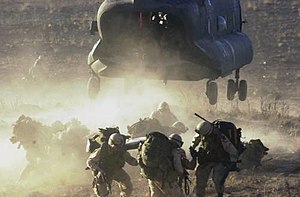Haqqani network basks in Pakistan sanctuary
 Image via Wikipedia
Image via Wikipedia...There is more.
Outnumbered by the Taliban and less famous than al-Qaeda, the Haqqani network nevertheless poses an intractable problem for U.S. troops, particularly as the focus of the war shifts toward the Pakistani border.
After an intensive focus on fighting Mohammad Omar’s Taliban in southern Afghanistan in 2010, the Obama administration is in talks, mediated by Germany and Qatar, with an Omar deputy. But a political deal with the Taliban — still a distant prospect — would not necessarily end the war in the east: the Haqqani network is seen as the least reconcilable of the Afghanistan war’s motley crew of insurgent factions.
The Haqqani family, protected from all threats save for the occasional U.S. drone strike in its Pakistani sanctuary of North Waziristan, has carved out a lucrative niche by exploiting the porous border with bribery and smuggling rings.
The Haqqanis rely on their Pashtun tribal connections and their patrons in Pakistan’s intelligence service, according to U.S. military officials. They hew to the relatively narrow goal of ruling a three-province swath of eastern Afghanistan that was once their exclusive domain but is now shared with thousands of American troops.
“They want power, wealth, money and a seat at the table when this thing is over,” Toner said.
The Haqqani fighters cooperate with the Taliban but are “not fully subordinate” to Omar and sometimes extract tolls from Taliban fighters who transit their territory, said a U.S. military intelligence official, who, like others, spoke on the condition of anonymity because he was not authorized to discuss the matter for the record.
Haqqani’s fighters slip into Afghanistan along mountain passes and historic trade routes, including several illegal border crossings used by hundreds of cargo trucks each day. The men generally fight in Afghanistan for many weeks before returning to Pakistan for a break of several months, U.S. officials say.
When in Afghanistan, the fighters move from village to village, never spending more than one night in the same house. They rarely use cellphones or radios, communications that can be picked up by U.S. surveillance technology, and know to exploit the “red zone” — the one-kilometer-wide buffer zone near the border that American soldiers do not enter without clearance from their commanders.
...
The titular head of the organization, Jalaluddin Haqqani, has been a militia leader for three decades, and he received money and weapons from the United States during the war against the Soviets....
...
The US is targeting their forces in Afghanistan, but needs to do more than introduce them to Hellfire missiles in Pakistan. If we do not mount an operation against them, we should plan an air strike to take them out on our way out of Afghanistan.

Comments
Post a Comment